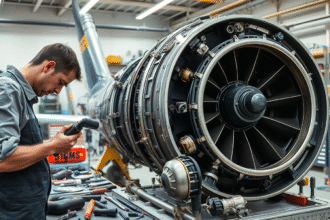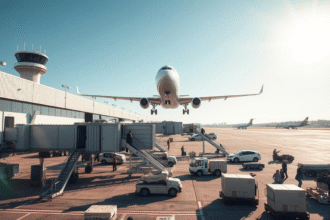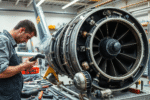The world is moving towards sustainable modes of transportation. The aviation industry is on the verge of a big change with electric airplanes. Soon, air travel will have less impact on the environment.
electric airplane
Zero-emission aircraft are set to change air travel for the better. They will make flying more eco-friendly. In this article, we’ll look at the tech behind these planes, their advantages, and the hurdles they must overcome.
Key Takeaways
- The aviation industry is adopting electric airplanes for zero-emission flights.
- Sustainable aviation is becoming a reality with electric aircraft technology.
- You can expect a significant reduction in environmental impact.
- The future of flight is being reshaped by innovative electric plane designs.
- Electric airplanes offer a cleaner alternative to traditional fossil-fuel-based air travel.
The Environmental Crisis in Aviation
When thinking about air travel’s future, it’s key to grasp the environmental hurdles the aviation world faces. The sector is under growing pressure to lessen its environmental harm. Aviation emissions are a major worry.
Carbon Footprint of Commercial Flights
Commercial flights are a big source of carbon footprint, adding to global greenhouse gas emissions. The aviation industry is responsible for about 2.5% of global CO2 emissions. This number is expected to increase as air travel grows.
aviation emissions
Other Pollutants from Jet Engines
Jet engines also release pollutants like nitrogen oxides, particulate matter, and sulfur dioxide. These emissions harm air quality and public health, making air pollution worse.
The Urgent Need for Sustainable Alternatives
The need for sustainable alternatives has sparked innovation in electric propulsion systems. Electric airplanes are a hopeful answer to cut down the aviation industry’s environmental impact. They’re leading the way to a greener future in air travel.
How Electric Airplanes Work
Electric airplanes are leading the way to a greener future. You’re about to learn how they use new tech to fly.
Electric Propulsion Systems
At the core of electric airplanes are electric propulsion systems. These systems use electric motors to push the plane forward, unlike old jet engines.
Motors and Power Distribution
The motors in electric planes are made for top performance and dependability. The power systems make sure energy gets to the motors right.
Efficiency Comparisons with Jet Engines
Electric motors beat jet engines in many ways. They’re more efficient and quieter.
electric airplane propulsion system
Battery Technology for Aviation
Batteries are key for electric planes. Better batteries mean planes can fly longer.
Current Energy Density Capabilities
Today’s batteries are getting better, with some reaching up to 250 Wh/kg.
Cooling and Safety Systems
Keeping batteries cool and safe is essential. It stops them from overheating and keeps them working well.
| Technology | Energy Density (Wh/kg) | Efficiency (%) |
| Current Batteries | 250 | 90 |
| Advanced Batteries | 300 | 95 |
Battery tech is getting better fast. This means electric planes will soon be a real option.
The Evolution of Electric Airplane Technology
Electric airplane technology is changing the future of flying. It’s making aviation more sustainable and eco-friendly. This change is driven by the need for better, greener solutions.
Pioneering Projects and Early Prototypes
The start of electric flight came from bold projects. These early tests showed electric planes could work. The e-Genius and Sunseeker Duo were among the first to show promise.
Recent Technological Breakthroughs
Recently, big steps forward have been made in electric planes. Better battery technology and electric propulsion systems have improved performance. These advancements are speeding up the creation of electric aircraft.
Research Institutions and Innovation Hubs
Research centers and innovation hubs are key to electric plane progress. Places like NASA and the European Union’s research initiatives are leading the way. They work with companies to push electric aviation forward.
| Institution | Project | Focus Area |
| NASA | X-57 Maxwell | Electric Propulsion |
| European Union | Clean Sky Initiative | Sustainable Aviation |
| University of California | Electric Aircraft Research | Battery Technology |
Current Electric Airplane Models Transforming Aviation
Commercial electric aircraft are set to change the aviation world. As we move towards greener options, many electric planes are being made. They promise to change how we fly in the future.
Commercial Electric Aircraft in Development
More electric planes are being made, leading the way. Two big examples are:
- Eviation Alice: A fully electric plane for short trips.
- Heart Aerospace ES-19: An electric plane for regional flights.
Eviation Alice
The Eviation Alice is a nine-passenger plane. It can fly up to 650 miles on one charge. It’s made for green, affordable travel.
Heart Aerospace ES-19
The Heart Aerospace ES-19 is a 19-passenger electric plane. It’s for regional airlines. It aims to cut down on emissions and costs.
Electric Air Taxis and Urban Mobility
Electric air taxis are being looked at for city travel. They could solve traffic problems. These planes are for short, low flights in cities.
Hybrid-Electric Solutions as Transitional Technology
Hybrid-electric planes are seen as a middle step. They mix old engines with electric power. This is a step towards fully electric flying.
Expect big changes in electric flying soon. Models like Eviation Alice and Heart Aerospace ES-19 are leading the way.
Benefits of Electric Airplanes for Modern Travelers
Electric airplanes are changing the game in aviation. They bring many benefits for travelers. As we move towards greener skies, electric planes will make flying better in many ways.
Noise Reduction and Enhanced Comfort
Electric airplanes are much quieter than traditional planes. This makes your flight more comfortable. A study found that electric planes could be up to 75% quieter.
“The quieter operation of electric airplanes will significantly improve the overall flying experience, making it more pleasant for both passengers and people on the ground.”
Potential for Lower Operating Costs and Airfares
Electric planes could save money on fuel and maintenance. This could lead to cheaper flights for you. Here’s a comparison of costs:
| Cost Component | Traditional Aircraft | Electric Aircraft |
| Fuel Costs | High | Low |
| Maintenance Costs | High | Lower |
New Routes and Regional Connectivity Opportunities
Electric planes could open up new routes. This means more travel options for you.
Smoother Flight Experience
Electric planes offer a smoother ride. This is because of their instant torque and fewer vibrations. You’ll enjoy a more comfortable flight.
In summary, electric airplanes bring many benefits. They reduce noise, lower costs, and offer new travel options. Plus, they make flying smoother.
Environmental Advantages of Zero-Emission Flights
The world is moving towards more eco-friendly flying. Zero-emission flights are leading this change. They offer big benefits for our planet.
Elimination of Direct Carbon Emissions
Electric airplanes don’t emit carbon during flight. This is a huge win for our planet. It helps fight climate change and makes air cleaner near airports.
Reduced Noise Pollution Around Airports
Electric planes are also much quieter. This means less noise for people living near airports. It makes their lives better.
Life-Cycle Environmental Assessment
To really see how green electric planes are, we need to look at their whole life. This means checking how they’re made, the batteries, and recycling.
Manufacturing Impact
Making electric planes is different from making old planes. We need to study how it affects the environment. This helps us understand their true impact.
Battery Production and Recycling
Batteries are key for electric planes. We must look at how they’re made and recycled. This helps cut down waste and lessen harm to the environment.
| Environmental Benefit | Description | Impact |
| Elimination of Direct Carbon Emissions | Zero emissions during flight | Significant reduction in greenhouse gases |
| Reduced Noise Pollution | Quieter electric propulsion systems | Improved quality of life near airports |
| Life-Cycle Assessment | Comprehensive analysis of environmental impact | Better understanding of overall environmental footprint |
Challenges Facing Electric Airplane Development
Electric flight is promising, but many hurdles must be cleared. Making electric airplanes is a complex task. It involves technical, regulatory, and operational challenges.
Battery Limitations
Battery tech is a big problem in electric airplane development. Two main issues are the weight-to-energy ratio and how fast they can charge.
Weight-to-Energy Ratio Problems
The weight-to-energy ratio of batteries is key for electric airplanes. Right now, batteries are too heavy for long flights. Advancements in battery technology are needed to fix this.
Charging Speed Constraints
Fast charging is vital to reduce downtime between flights. But, rapid charging technologies are not yet ready. Their implementation is a big technical challenge.
Range and Payload Restrictions
Electric airplanes have big range and payload limits. These limits make it hard to use them on commercial routes, like long-haul flights.
Certification and Regulatory Hurdles
Certification for electric airplanes is changing. Regulatory bodies must create and update standards. They need to ensure safety and encourage innovation.
Weather Sensitivity and Operational Challenges
Weather, like extreme temperatures, can impact electric airplane performance and range. Also, there are operational challenges, like maintenance and training, to tackle.
In summary, electric airplanes are promising, but we must overcome these challenges. Their successful development and use depend on it.
Infrastructure Requirements for Electric Aviation
Building the right infrastructure is key for electric airplanes to fly commercially. As we move towards zero-emission flights, airports and their systems must change. They need to support this new technology.
Airport Charging Stations and Power Supply
Installing airport charging stations is a top priority. These stations must charge planes quickly and efficiently. High-power charging technology is being developed to meet these needs.
Grid Capacity and Renewable Energy Integration
The need for more electricity to charge planes is growing. Upgrading the grid is essential. Using renewable energy sources in the grid is also key. This ensures the electricity is clean and sustainable.
| Infrastructure Component | Current Status | Future Requirements |
| Charging Stations | Limited | High-power, widespread |
| Grid Capacity | Adequate for current needs | Significant upgrades needed |
| Renewable Energy | Growing integration | Majority of energy supply |
Maintenance Facilities and Technical Support
Maintenance facilities will need to adapt for electric aircraft. They must have specialized technical support.
Training Programs for Pilots and Technicians
Training programs for pilots and technicians are vital. They need to learn how to handle electric aircraft safely and efficiently.
Timeline for Electric Airplane Adoption
The timeline for electric airplanes is getting clearer. We’re seeing big steps forward. Different parts of aviation will start using electric planes at different times.
Short-Haul Flights (2025-2030)
Short-haul flights will be the first to use electric planes. These flights are shorter and use smaller planes. This makes them easier to start with.
Regional Flights (2030-2035)
After short-haul flights, regional flights will follow. This will bring electric planes to more airports. It will help connect areas better and more greenly.
Medium-Range Capabilities (2035-2040)
As batteries get better, we’ll see flights that go a bit further. This is a big step for electric flying. It means we can travel longer without using old fuels.
Long-Haul Prospects and Technological Barriers
Long-haul flights are the biggest challenge. They need a lot of energy and batteries aren’t there yet. We need big tech advances to make these flights possible.
| Flight Category | Expected Timeline | Key Features |
| Short-Haul | 2025-2030 | Smaller aircraft, shorter distances |
| Regional | 2030-2035 | Larger scale adoption, regional connectivity |
| Medium-Range | 2035-2040 | Improved battery technology, longer distances |
| Long-Haul | Beyond 2040 | Significant technological breakthroughs required |
Economic Impact of the Electric Aviation Revolution
The electric aviation revolution is changing air travel in big ways. It’s not just about the environment anymore. It’s also about the money.
Cost Analysis for Airlines and Operators
For airlines and operators, the cost is a big deal. Electric planes could save a lot of money. They use electricity, which is cheaper than jet fuel. They might also need less maintenance because they have fewer parts.
Job Creation in Green Aviation Technologies
Switching to electric planes will create new jobs. There will be roles in making, fixing, and supporting these planes. This includes jobs in the tech needed for electric planes.
Government Incentives and Policy Support
Government incentives are key for electric planes. Governments can help with money, tax breaks, and research funding. This support is important for the sector to grow.
Investment Opportunities in the Sector
The electric aviation sector is a good place for investments. Private and public money can make a big difference. Investing in tech, infrastructure, and services could pay off as the industry grows.
In summary, the electric aviation revolution will affect many areas. It will change costs, jobs, policies, and investments. As the industry grows, understanding these changes is vital for everyone involved.
Conclusion: Embracing the Electric Future of Flight
Electric airplanes are a big step towards a greener aviation industry. They are not just a dream; they are becoming a reality. This change will greatly improve air travel.
Zero-emission flights are coming, which will help the environment a lot. Electric planes are cleaner than old planes, cutting down on pollution. As technology gets better, flying will be quieter and better for the planet.
The shift to electric planes is already happening. New battery tech, electric engines, and better airports are key. Moving towards electric planes is key for a cleaner sky and a greener future.
FAQ
What is an electric airplane?
An electric airplane uses electric motors and batteries instead of fossil fuels.
How do electric airplanes reduce environmental impact?
They cut down on carbon emissions and make less noise around airports.
What are the benefits of electric airplanes for travelers?
They offer quieter flights, more comfort, and could be cheaper. They also open up new routes and improve regional travel.
What are the challenges facing electric airplane development?
Challenges include battery limits, range and weight issues, and getting through regulations. Weather also poses a problem.
What is the expected timeline for electric airplane adoption?
Adoption is moving forward. First, short-haul flights will benefit, then regional ones. Eventually, they’ll cover longer distances.
What infrastructure is required to support electric aviation?
We need charging stations at airports, better grid capacity, and places for maintenance. Training for pilots and techs is also key.
How will electric airplanes be certified?
They’ll meet new safety standards set by aviation authorities. This ensures they’re safe to fly.
What is the economic impact of the electric aviation revolution?
It’s big. Airlines could save money, and it could create jobs. There are also chances for investment in green tech.
Are there any commercial electric aircraft currently in development?
Yes, models like Eviation Alice and Heart Aerospace ES-19 are being worked on.
How do electric airplanes work?
They use advanced electric systems and batteries. Motors and power systems are made for efficiency. They compare well to traditional engines.







